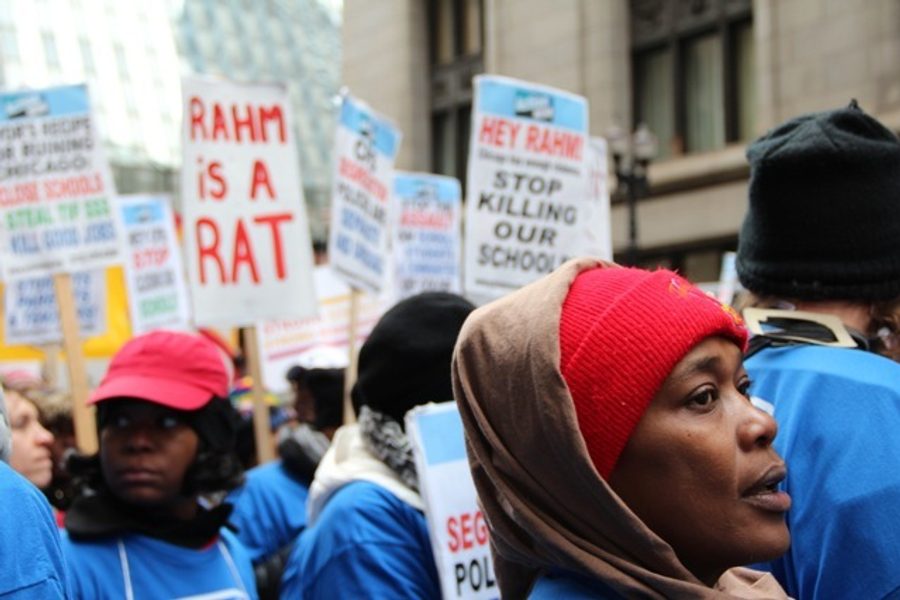In the first three pages of her new book on Chicago Mayor Rahm Emanuel, Kari Lydersen shares an anecdote that all but summarizes the current dynamic in Chicago politics: In March 2012, the mayor attended a gala at the Chicago History Museum to celebrate the city’s 175th birthday. As the Chicago Children’s Choir sang “Happy Birthday” while Emanuel looked happily on, a woman in a floral headscarf charged up, interrupting the festivities to plead with the mayor not to go forward with his plan to shutter half of Chicago’s mental health clinics. “We’re going to die,” she begs. “There’s nowhere else to go. … Mayor Emanuel, please!”
That woman was Helen Morley, an indefatigable activist and mental health patient who had earlier that winter led a sit-in at City Hall to try to save the clinics. Emanuel, Lydersen writes, dutifully avoided making eye contact with Morley or acknowledging her presence. Instead, he shook the hands of friendly patrons and moved along before the birthday cake was even cut. Within a few months, the clinics were closed, and Morley was dead. The cause was a heart attack, but her friends were certain that the stress of the clinic closures played a role.
From a vantage point high above the Loop, Chicago is the picture of modern capitalism: glistening office towers, parks and architectural monuments named after billionaires, and a string of Pret A Manger cafes. If construction goes forward, the little grit of yesteryear still remaining downtown will be subsumed by expensive new hotels and a $173 million basketball arena for the private DePaul University, paid for in substantial part with public funds.
But on the ground, Chicago is also a city in which protesters occupy hospitals to demand trauma care on the South Side, where it’s not uncommon to see CTA riders wearing Chicago Teachers Union T-shirts, and where nearly 50 neighborhood elementary schools sat vacant at the start of this year, casualties of the city’s “school reform” plan.
These are the two potential legacies of Rahm Emanuel.
Though billed as a biography, Mayor 1%: Rahm Emanuel and the Rise of Chicago’s 99% is better regarded as a thorough sizing up of which legacy will prevail. Lydersen, a veteran Chicago journalist (and contributing editor to In These Times), pairs an admirably even-handed account of Emanuel’s career with extensive reporting on the grassroots opposition he’s engendered.
In Lydersen’s account, Emanuel comes off as a thin-skinned, perpetually networking, intensely driven egoist whose greatest fortune seems to have been in realizing how well his personal style meshed with the neoliberal project pursued by the Democratic Party over the past few decades. Rising up quickly through the ranks of the party, Emanuel took a job in Bill Clinton’s 1992 presidential campaign and then a post in the Clinton administration, where he helped establish the agenda of the pro-business Democratic Leadership Council. Emanuel parlayed his success into a lucrative career in investment banking, followed by a congressional seat, a stint in the Obama White House and finally the mayorship of Chicago.
Lydersen questions how well the impersonal style of the Washington circles where Emanuel cut his teeth translates to a local level. “Emanuel’s critics and admirers have both described him as a quintessential creature of Washington,” she writes. “He clearly knows how politicking works. But being mayor is different, or at least it should be.”
To an executive such as Emanuel, Chicago may appear less a mosaic of cultures, experiences and histories than a structure built of interchangeable parts. Longtime union jobs with the city, for example, can be changed out for outsourced nonunion work. A school in one neighborhood can be closed, its students shunted to a different school, in a different neighborhood, with little concern for the consequences to either community. And a rich urban space can be replaced with an array of tourism-oriented, TIF-funded development projects, as in neighborhoods such as Uptown and Logan Square, where public subsidies fuel businesses like breweries and shopping centers while rising rents displace longtime residents.
Even the patronage jobs that long greased the gears of the Chicago Machine — jobs that, however ill-dispensed, were still public-sector jobs for Chicagoans — have succumbed to the drive to privatize.
All of this has produced among critics a creeping nostalgia for the Daley era. Despite their offenses — corruption, dubious business deals, segregation — the father and son Daley were regarded as adoring caretakers of the city they ruled. Richard J. Daley, the elder, was reputed to have stopped to pick up overturned garbage cans as he surveyed his kingdom on his morning commute to City Hall. The junior Daley held his political meetings over corned beef sandwiches and paper cone cups at Manny’s Deli.
Emanuel is surely a beneficiary of the power the Daleys consolidated in city hall during their terms. Still a one-party town, Chicago also boasts a city council in which any dissenting votes are uncommon, and a mayor-appointed school board that critics deride as unaccountable. But there’s a prevailing sentiment that the mayor, though probably not any more powerful than the Daleys, is less encumbered with a personal concern for the city that he governs.
“Daley was a lunch bucket Democrat,” one city official tells Lydersen. “He knew the drivers of the garbage trucks, he knew the tree trimmers, he knew their parents. Rahm has no clue who the drivers are, and he doesn’t care. … But you ask him who the head of the Chicago Mercantile Exchange is, and he’ll have him on speed dial.”
Will Emanuel’s detachment from the lives of ordinary Chicagoans end up doing him in?
Against the narrative of Emanuel’s drive to remake the city, Lydersen sets accounts of the activism that has taken place in Chicago under his watch. With the structures of traditional democratic representation all but dismantled, labor unions, progressive organizations, and community and religious groups have increasingly had to rely on a different kind of politics — one that’s more willing to eschew the old manner of bargaining with the city in favor of independent organizing and often-confrontational tactics.
There’s the story of Mental Health Movement activists who occupied a clinic in Woodlawn slated for closure and brought bags of cement they planned to use to seal the doors to keep the police out. Another chapter recounts the takeover of the Chicago Teachers Union by a rank-and-file caucus that ultimately led 30,000 union members to a seven-day strike. And a chapter on last spring’s NATO summit describes the mass street mobilizations led, in one instance, by hundreds of nurses clad in red scrubs and green Robin Hood caps to demand healthcare paid for by financial speculation tax.
While opposition to Emanuel and his program hasn’t reached the point of broad unification, the mayor is providing the fractured discontented with a single target. This week, 2,000 Chicagoans gathered at a “Take Back Chicago” rally at the UIC Forum, organized by the Grassroots Collaborative, an umbrella group of 11 unions and community organizations. There, nurses, students, homeless advocates and union members denounced the mayor’s program and laid out a sketch of a “new people-focused agenda.” Alliances such as these are likely to form the basis of an electoral campaign against the mayor when he comes up for re-election in 2015; the Chicago Teachers Union — whose strike last year came the closest so far to bringing together large and diverse sections of Chicago’s working class — appears to be anticipating such a challenge, and is making an effort to register 100,000 new voters throughout the city.
“The decisions we make in the next two to three years will determine the face of Chicago for the next 20 to 30 years,” Emanuel told TIME earlier this year.
That’s undoubtable true. And so Lydersen’s book arrives at a critical time, presenting Chicago’s 99% with a question whose answer has yet to be determined: In the end, whose city will it be?






